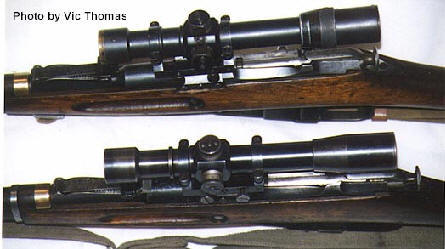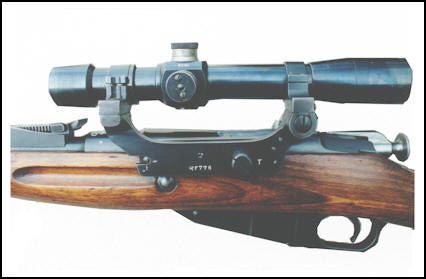91/30 PEM Sniper

Getting
a handle on the origins of the Soviet Sniper program is not easy. Most
sources indicate that it began in the early 1930's while others claim
it was started in principal almost immediately after the conclusion of
the First World War. It is no doubt true that the Soviets saw the use
the use of sharp shooters as being critical from their experiences in
WWI and began test programs almost immediately to integrate sharp
shooters into their battle doctrine. However, these sharp shooters
would most certainly have been equipped with standard infantry rifles
and considered as scout or observation elements. The development of
optical sights did really come into their own until the Germans began
aggressive development programs in the 20's. I would submit that it
wasn't until the use of optical sights and the improvements called for
in the 19/30 program were converged that the Soviets began a real
sniper program. Wrobel places this period as beginning in 1931 whereas
a Soviet magazine article references 1927 or 1928. I will put my money
on Karl-Heinz Wrobel's findings in that he is able to cite credible
research sources. Either way, the two technologies of optics and
improved battle rifles had to mature before an effective sniper rifle
could be developed.
The
Early Years
The
Soviets began their sniper program with optics from the German firm
Zeiss who were world renown for the quality of their optics. Although
different optical sights had been experimented with, the first
production series snipers were equipped with Zeiss-Dialythan model
scopes.

A
quick note about optics
There
are two terms associated with the optics used on sniper rifles that
often misunderstood and confused. The general use of a sight that
features a tube with glass objectives can be termed as the use of
scopes. However, within that classification are two sub-sets:
telescopic sights and optical sights. Telescopic sights allow for the
adjustment of the focal length and magnification of the sight while the
optical sights are fixed in focus and magnification.

The PE
The
first series of Soviet sniper rifles used the Model PE scope (VP in the
Soviet designation) which was produced by the company Emil Busch AG and
was basically a knock-off the Zeiss optics used on the first
prototypes. This series of rifles ran from 1931 to 1939 with some
evidence indicating that the production run went into the early 40's to
use up surplus parts from the official production run. The PE scope is
identified by its length which extends from just even with the iron
sight base back to just beyond the cocking piece on the bolt and the
use of an adjustable objective or eyepiece. The PE was a 4 power scope
that featured adjustments for elevation and windage as well as the
focus ring. The first mounting system was a hex shaped affair that
mated with the hex receiver and mounted the scope on the centerline of
the bore. This centerline mount was later adapted to the round
receivers. Later mounting systems for the PE and PE/PEM series were
side mounts that attached to a base affixed to the left side of the
receiver.
PE/PEM
Defined
The
two early models of scopes mounted on the 91/30 were referred to as PE
and PEM which stands for "unified model" and "unified model modern"
respectively. The difference between the two are significant as the
early PE allowed for focus adjustment whereas the PEM did not. The move
away from the focus ring was to simplify production and to attempt to
stem reported problems with the scopes "leaking" due to poor
seals. There is some confusion over the designation PE/PEM which
according to the source you read designates a transitional production
series from 1937 through 1939 or the entire series of rifles produced
after the introduction of the PEM.

More
On Mounting
In
1938 the PEM received the side mounting system that attached to the
left side of the receiver in a side rail. This mounting system allowed
better access to loading the weapon and gave more clearance for the use
of the iron sights on the weapon. It should be noted that finding one
of these examples today is extremely rare and the scope and mounting
system when sold on the market tends to sell in excess of $1500 or
more.
Other
Snipers

Although
the 91/30 was the standard sniper rifle in the 30's, Tokarev made a bid to modernize the
sniper rifle with the development of the SVT38 and later SVT40. Both of
these rifles were semi-automatic designs that fired the same 7.62x54r
round as the 91/30. However, both rifles were plagued with problems
related to accuracy and excessive noise and muzzle flash. However they
did introduce the PU optical sight which later appeared on the 91/30
Sniper. Construction of the SVT40 was discontinued due to the complex
machining required and the clear advantages of the 91/30.
Production
Production
of the first 91/30 Snipers did not officially begin until 1931 at Tula
Arsenal. However, as pointed out above, there were a series of Dragoons
that sported the Zeiss-Dialythan prior to that time as well as a series
of other scopes. Interestingly, The only solid production figures
listed by Karl-Heinz are for Ishevsk and even those figures are spotty
at best. Vic Thomas seems to have a better handle on the figures but I
am puzzled why the source of those figures were not shared with
Karl-Heinz unless it was a matter of information that became available
after Drei Linien was published. Since this section is intended as an
overview, I would gladly refer the reader to Vic's article on Mosin
Nagant dot Net. Irrespective of the production figures, there is a
difference it seems between rifles produced by Tula and those produced
by Ishevsk. Tula marked the barrels of their rifles with the
distinctive Ch marking where Ishevsk did not use any special markings.
In both cases, the arsenals hand selected the sniper rifles from normal
production runs based on fit and finish, bore quality and accuracy
testing. Some sources say that the rifles were later tweeked for
accuracy before being issued by polishing the chambers and slightly
modifying the triggers. Production of the prototype/Dragoon models ran
from about 1927 to 1930. The PE series ran from 1931 to 1936 or
possibly as late as 1939 and beyond. The record shows the PEM as
running from 1937 to 1942. The confusion over the dates may be due to
records being lost at Tula as well as the Soviet penchant for using all
the parts of a particular series even after the series ends.

Legacy
The
PE/PEM series of sniper rifles defined the Soviet commitment to a
sniper program and laid the groundwork for the 91/30 PU model which
remained in service until the 1960's and still serves on battlefields
around the world today. No other sniper rifle was produced in greater
numbers at the time as the PE/PEM series nor did any other sniper rifle
have such a profound impact on the tactics and battle doctine of an
army far into the late 20th Century.
|

